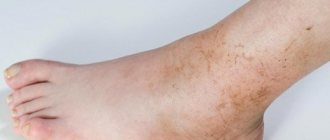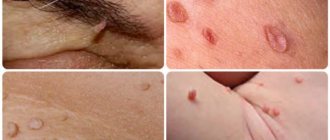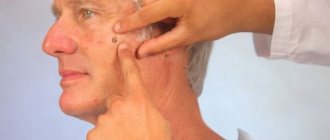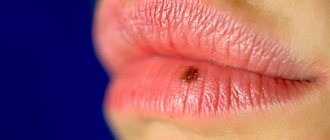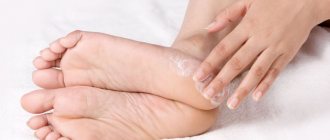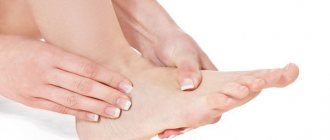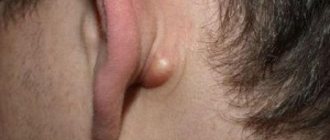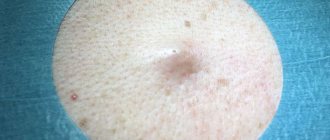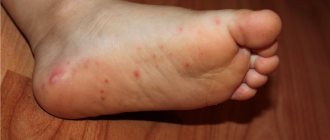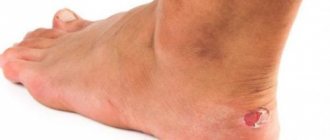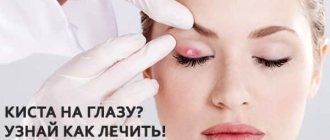Many will be surprised to hear that warts on the legs are not just a cosmetic defect that causes discomfort, but an infectious disease caused by papillomavirus (HPV).
After the pathogen enters the body, a small benign tumor appears on the skin, which looks like a papule, old callus or corn (the appearance depends on the strain of the pathogen).
In order to promptly identify and treat a contagious disease, it is necessary to familiarize yourself with the signs and consider ways to get rid of warty growths.
Causes and symptoms of appearance on the legs
Reasons for the appearance of keratinized seals:
- calluses from uncomfortable shoes;
- corns on the heel;
- age wear.
They differ from foot warts in that they appear where they rub when walking. Growths of viral origin grow chaotically anywhere on the leg and have nothing to do with calluses.
The root of the problem is the human papillomavirus. There are about 170 types of infection, all of which provoke the appearance of papillomas, warts, and condylomas. More than 70% of the world's population is infected with HPV. But the virus manifests itself in people with weakened immune systems.
Need advice from an experienced doctor?
Get a doctor's consultation online. Ask your question right now.
Ask a free question
The main symptom of HPV activity in the body is the appearance of growths. A wart on the foot looks like it depends on its variety: there are flat, regular, and plantar (spike). The most common ones on the feet are plantar. They can be recognized by a dry, keratinized surface with a depressed or slightly convex apex - in the form of skin processes. Over time, black dots appear on them - the result of blockage of small blood vessels.
In these cases, the warts are treated by a doctor
if the wart is located in intimate places if the tumor bleeds, tears or itches if the wart is not uniform in color if it very quickly changes color, shape, or all together if it hurts or it is constantly injured (this increases the risk of its degeneration into something very serious) if the amount warts begin to grow rapidly if the borders of the warts are blurred or you are not sure that it is a wart. The answer can only be given by a specialist after examination.
Video: Elena Malysheva about warts
These materials will be of interest to you:
Similar articles:
Treatment of psoriasis at home - natural remedies help best Psoriasis is a chronic recurrent dermatosis of non-infectious etiology, affecting mainly the skin... Treatment of papillomas at home with folk remedies, as well as at home from the pharmacy Papillomas are small benign tumors measuring 0.2-10 millimeters in color... How to get rid of keratomas at home? Keratoma is a skin formation consisting of keratinized epidermal cells that appears...
What types of HPV cause warts?
Plantar and knee formations grow due to 1, 2 and 4 strains of HPV. Types of papillomavirus provoke the appearance of warts on the palms.
Strains 1, 2 and 4 of the human papillomavirus are transmitted through household contact and sexual contact. Touching an infected person is enough to become infected. But this does not always happen; for the virus cells to penetrate the basal layer of the epithelium, where it is localized, the skin must be damaged. Infection through contact with infected people does not occur in 100% of cases.
Symptoms
Plantar warts are difficult to confuse with other skin diseases. The main manifestations here are itchy sensations during movement. As the volume of growths increases, the latter itch more and more. Contact with them may cause pain.
The final formation of a wart takes about a month. During this time, rough sensations develop on the surface of the skin of the foot. Dark dots form at the site of the neoplasm itself. The skin gradually becomes rougher, the warts grow in width, connecting with each other.
Features of localization on the legs and types of warts
The localization of warts on the feet is chaotic, most often manifesting as plantar formations on the foot.
The main types of warts on the legs, localization features:
| Name of wart | Location | Characteristic |
| Rod | On the foot, heel, on the toes, between them. |
|
| Flat | On the shin, knees, inner thigh, top of the foot. |
|
| Dry (plantar) | On the supporting area of the feet, the heel, on the bottom of the toes. |
|
Warts on the soles of the feet are especially dangerous. They get rubbed by shoes, get wet from sweat, and in winter they become hypothermic. Rapid development, emergence of complications.
Growths on the perineum, inner thigh with a loose appearance, soft surface - condylomas. They are caused by urogenital types of HPV and do not belong to strains 1, 2 or 4.
How to remove a wart?
Laser wart removal is effective and painless
Many people are interested in how to remove a wart on a thin stalk. Modern medicine offers many ways to get rid of tumors. It is necessary to engage in treatment only after accurately establishing the type of growth. Incorrect treatment can cause serious harm. In some cases, it contributes to the degeneration of the wart into a malignant process.
To remove warts, medications, surgical techniques, and traditional medicine are used.
Medications
To remove a warty growth, the following medications are used:
- Cryopharma. It works by freezing the wart, just like liquid nitrogen, but this drug can also be used at home. The product is designed for external use. It is necessary to apply a few drops of the drug to the neoplasm, then leave until completely dry. This manipulation should be repeated after 14 days. The number of procedures is individual in each case. Use until the growth falls off on its own. The drug has a number of contraindications - it is prohibited for patients with diabetes, as well as for pregnant women. The average cost is 1000 rubles.
- Warter Cryo. Used to remove warts whose diameter does not exceed 7 mm. The principle of action is similar to the previous drug. It is necessary to use with extreme caution, avoiding contact with healthy areas of the skin, as there is a high risk of injury. The cost of such a drug is 700 rubles. The duration of treatment depends on the number of warts and the individual characteristics of the person.
- Castor oil. It is one of the most budget-friendly pharmaceutical products that help get rid of warts. The skin must first be steamed, then oil must be applied and secured with a band-aid. The exposure time of the patch is 30 minutes. After the growth has softened, it can be carefully removed using pumice. If the growth does not respond well, then the manipulation is repeated. The average cost is 40 rubles.
Before using any medication, it is recommended to first consult a dermatologist.
Surgery
Currently, there are many techniques to remove a wart. At the same time, they are gentle and do not require a long rehabilitation period. A surgical scalpel is used extremely rarely, in cases where other methods do not give the desired result.
Among the gentle methods, the following are the most popular:
- Laser removal. It is the most popular and effective way. Its only drawback is its relatively high cost. Laser removal is not carried out in budgetary medical institutions, and in a private clinic the average cost is 1500-2500 rubles. Considering that the procedure is one-time, its cost is quite justified. The laser allows you to get rid of any tumor without pain or discomfort.
- Cryodestruction. It involves removing the growth using liquid nitrogen. Under its influence, the growth freezes, after which it disappears on its own. The procedure does not cause pain, but if sensitivity is high, local anesthesia is an option. The average cost is 1000 rubles, but in some cases a course of such procedures may be required.
- Removal by radio waves. Removal is carried out by exposing the growth to high-frequency radio waves. A special electrode converts electric current into electromagnetic waves. The average price of such a procedure is 700 rubles.
- Chemical removal. The process is based on treating papilloma with special preparations. When carrying out such a procedure, there is a high probability of chemical burns, so it is very important to protect healthy skin. There are drugs for carrying out such manipulations at home, but in this case the likelihood of developing negative consequences is extremely high. It is recommended to carry it out only in a hospital setting. The cost varies from 500 to 800 rubles.
Before carrying out the wart removal procedure, you should consult your doctor to choose the most suitable method.
ethnoscience
Traditional methods are allowed to be used only as additional treatment, since their effectiveness is low. Each method requires long-term use. The most common options for removing warts are:
- Rubbing with celandine juice. It is worth considering that it can cause burns, so it is necessary to avoid getting the juice on healthy areas of the skin.
- Apple cider vinegar compresses. It is recommended to apply the compress overnight, then thoroughly rinse the affected area with clean water.
- Onion compresses. The onion must be finely chopped, wrapped in gauze or a medical bandage, then applied to the location of the wart and securely fastened. The holding time of such a compress is from 3 to 4 hours.
- Garlic. Also used as a compress, the technology is identical to the previous method. It is allowed to carry out such compresses daily several times a day.
When using any traditional medicine methods, it is worth considering that all natural components differ in their ability to cause the development of allergic reactions. Therefore, before starting therapy, it is necessary to make sure that there is no allergy and begin treatment gradually.
It is recommended to give preference to traditional methods - drug and surgical treatment.
What to do if the growth hurts
Pain in the legs occurs as a result of damage to the growth from the outside. More often occurs with formations in conditions of rubbing and sweating. This is especially true for uncomfortable shoes - the growths are constantly in contact with the sole, rubbing, in the summer they sweat, and in winter they can become hypothermic.
Procedure for pain in the growth:
- Isolate the foot (or other place) from friction and compression. Do not wear shoes or replace them with loose ones with soft insoles.
- Ensure dryness - in a humid environment, infections and fungi make their way into the inflamed formation more easily.
- For walking, secure it with soft material - you can bandage it or cover it with an antibacterial bandage. You will prevent infection and reduce damage from the rough surface of the sole.
- Consult a doctor - it is difficult to cure an inflamed formation on your own.
Prolonged ignoring of pain will lead to suppuration, itching, and the growth of warts on the leg into new formations.
An examination by a dermatologist is necessary - the doctor will take a piece of the growth for histological examination and prescribe the correct treatment.
Pain in the growth may be accompanied by fever, drowsiness, weakness - infection in the damaged wart and its growth.
Preventive measures
To prevent the appearance of warts on the skin of the legs, a person should be careful about their health and personal hygiene rules.
In public places (baths, saunas, swimming pools, showers) you must wear shoes. This will prevent the virus from getting on the skin of the feet and thus protect the person. In cosmetic and tattoo parlors, you need to pay attention to the processing of the devices used. If it is not carried out fully or is absent altogether, it is better to refuse the services of such an institution. When visiting, it is better not to wear other people's slippers. You should not use other people's hygiene items or wear someone else's clothes.
Following simple preventive rules will help to avoid many unpleasant moments, including the appearance of warts on the legs.
Many people are accustomed to not taking warts on their feet seriously.
However, if you do not seek help in time, this phenomenon can lead to a number of complications and significantly affect the quality of life. The article has been verified by the editors
Treatment methods for warts
A wart on the knee is easier to treat than on the feet. The skin here is more sensitive, softer - it is easier to harm it when removing the growth. But it happens less often than from rubbing the plantar projections on the floor. The best method of therapy is the one that makes the formation disappear on its own, without radical intervention or risks of complications.
For starters, traditional methods using natural extracts, plant juices, and natural immunomodulators are suitable.
At the initial stage, all types of warts that appear on the legs are treated:
- Celandine. To use, pick 2-3 large flowers and cut the stem. Apply the flowing juice to the young wart. A cauterization effect is created; repeating the procedure 2-3 times a day for 1-2 weeks will make the growth fall off.
- Garlic. Crush 1-2 heads in a garlic press, add olive oil, apply growth agent in small portions, clamping with an antibacterial bandage.
- Potatoes. Cut the tuber in half, lubricate with alcohol or vinegar, apply to the formation 2-3 times a day until it falls off and heals.
Additionally, when treating at home, use essential oils (tea tree, celandine, etc.). They increase immunity, and when applied generously, they burn the skin along with the root system of the wart on the leg.
Do not overdo it; after each treatment, wash off the applied liquid to prevent deep damage.
To remove already overgrown growths, it is better to resort to outpatient methods:
- Cryodestruction – removal with chilled liquid nitrogen.
- Diathermoelectrocoagulation – cauterization with electric current.
- Radio waves - influencing the structure of the wart on the leg with high-frequency sound waves.
- Laser therapy – burning with a laser beam.
The essence of treating growths is to suppress the HPV virus. The pharmaceutical drugs Verrukacid, Acyclovir, Viferon are suitable. They have an antiviral and immunostimulating effect.
Medicines for plantar warts
The composition of drugs for removing papillomas includes antiviral compounds, immunomodulators or substances that loosen the stratum corneum of the skin. Pathogens that suppress the reproduction include:
- Fluorouracil: 5% cream for topical use, activates protective cells, slows the growth of warts;
- Imiquimod: promotes the production of interferons, prevents further damage to the skin;
- Viferon: gel for external application, has high antiviral activity.
These drugs have virtually no side effects, but at an advanced stage of papillomatosis they are ineffective. To destroy and remove large warts, keratolytics, necrotizing agents, and cryogenic agents are used. All of them require careful handling, as they contain acids, alkalis and other chemically active components. Dermatologist approval is required before use.
Popular remedies for warts:
- Salipod: a patch with salicylic acid, softens the affected layers of the skin, allowing you to remove the wart and get to its root;
- Super celandine: a solution that “burns out” the keratinized layers, promotes necrotization and death of papillomas;
- Cryopharma: a solution in aerosol form, contains a nitrogenous compound that freezes areas of affected tissue.
These medications must be applied pointwise to warts, strictly following the instructions so as not to damage healthy skin. The period of death of warts after their use: from 5 to 20 days. In advanced cases, you need to repeat the procedure. Remains of papillomas must be removed mechanically, and wounds must be treated with iodine solution.
